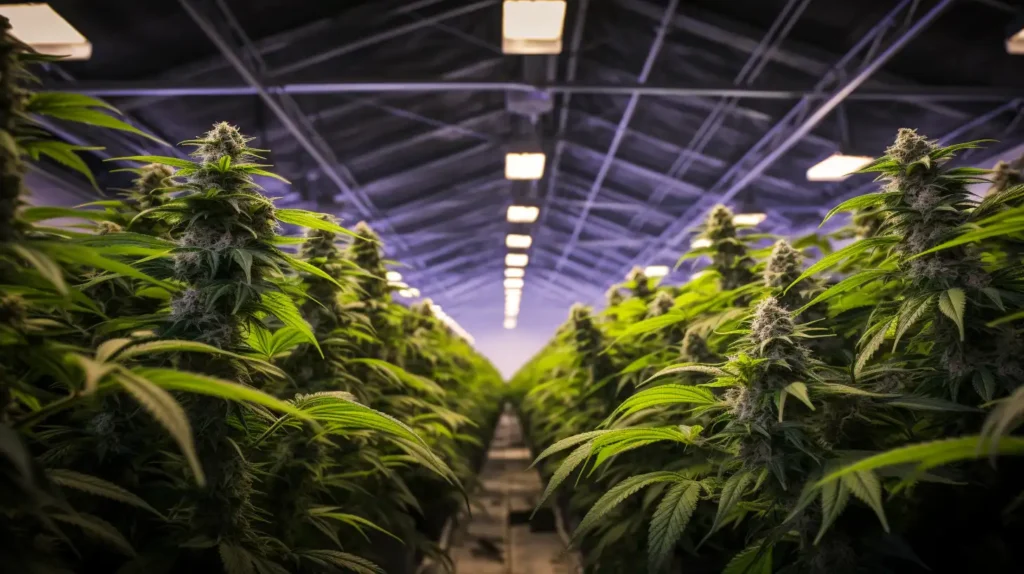Introduction to Organic Cannabis Growing
Organic cannabis growing refers to the cultivation of cannabis plants using organic methods and techniques, without the use of synthetic pesticides, fertilisers, or other chemicals. This natural approach focuses on creating a healthy and sustainable environment for the plants to grow and thrive in.
There are many benefits to growing cannabis organically at home, including:
- Health Benefits: By eliminating the use of chemicals, you can ensure that your cannabis is free from harmful residues and chemicals, making it safer for consumption.
- Environmental Benefits: Organic growing methods are better for the environment, as they do not contribute to pollution or harm natural ecosystems.
- Cost Savings: Growing cannabis organically at home can save you money in the long run, as you will not need to constantly purchase expensive synthetic fertilisers or pesticides.
To get started with organic cannabis growing, there are a few basic elements to consider, such as soil, lighting, and nutrients. But there are also some natural techniques that can help improve the health and yield of your plants, such as companion planting, composting, and natural pest control methods.
If you are interested in starting your own organic cannabis garden at home, here are some steps to follow:
- Choose the Right Seeds: Look for organic seeds from reputable sources to ensure the best quality plants.
- Prepare the Growing Space: Make sure you have enough space, proper lighting, and good air circulation for your plants to thrive.
- Germinate Seeds: Follow proper germination techniques to ensure successful growth. It is essential to avoid common mistakes when growing organic cannabis, such as overwatering, using chemical fertilisers, and not controlling pests and diseases. These can harm your plants and reduce your yield.
Once your plants are ready for harvest, it is important to handle them carefully. This includes proper harvesting techniques and drying and curing methods to preserve the quality and potency of your cannabis.
If you want to learn more about organic cannabis growing, there are resources available such as online forums, books, and classes. With dedication and the right techniques, you can successfully grow organic cannabis at home and enjoy all its benefits.
What is Organic Cannabis Growing?
Organic cannabis growing refers to the cultivation of cannabis using natural and sustainable methods without the use of synthetic fertilisers, pesticides, or other artificial chemicals. This approach focuses on harnessing the power of organic materials and techniques such as composting, crop rotation, and beneficial insect cultivation to promote plant health and vitality. It also emphasises the importance of soil quality and biodiversity to support the growth of cannabis plants naturally. By avoiding synthetic additives and prioritising eco-friendly practices, organic cannabis growing aims to produce high-quality, chemical-free cannabis that is better for both consumers and the environment.
Why Choose to Grow Cannabis Organically at Home?
As the popularity of cannabis continues to rise, so does the desire for organic methods of cultivation. But why choose to grow cannabis organically at home? In this section, we will explore the various reasons for choosing this natural approach to growing cannabis. From the health benefits of consuming organic cannabis to the positive impact on the environment, and even potential cost savings, there are many compelling reasons to consider this method of cultivation. Let’s dive into the details and discover why growing organic cannabis at home may be the right choice for you.
1. Health Benefits
Improved nutritional value: Organic cannabis may contain higher levels of beneficial nutrients, potentially boosting health benefits.
Reduced exposure to harmful chemicals: Growing cannabis organically minimises the risk of ingesting toxic substances from chemical fertilisers, pesticides, and herbicides, contributing to better health.
Enhanced taste and aroma: Organic cultivation methods can lead to a more flavourful and aromatic end product, providing a more enjoyable experience.
2. Environmental Benefits
Reduced environmental impact: Organic cannabis growing minimises the use of synthetic pesticides and fertilisers, preventing potential soil and water contamination.
Promotes biodiversity: By avoiding harmful chemicals, organic cultivation supports diverse ecosystems and protects beneficial insects and organisms essential for a healthy environment.
Conserves natural resources: Organic methods prioritise sustainable practices, such as water conservation and soil health management, contributing to overall environmental preservation.
3. Cost Savings
Consider growing from seeds for long-term cost savings. Invest in high-quality soil for better plant health and reduced need for additional nutrients. Use natural pest control methods such as companion planting to avoid expenses on chemical pesticides. Employ composting to create nutrient-rich soil, reducing the need for store-bought fertilizers. Choose energy-efficient lighting to lower electricity costs during the growth phase.
When my friend started growing organic cannabis at home, they focused on cost savings. By composting kitchen waste, using companion planting to deter pests, and investing in quality soil, they managed to significantly reduce their expenses while producing high-quality organic cannabis.
What Are the Basics of Organic Cannabis Growing?
When it comes to growing cannabis, there are various methods and techniques that can be used. However, for those who prioritize natural and sustainable growing practices, organic cannabis growing is the way to go. In this section, we will discuss the basics of organic cannabis growing, starting with the foundation of any successful plant growth: the soil. Then, we will explore the importance of lighting and how it can affect the health and potency of your cannabis plants. Lastly, we will touch on the use of nutrients in organic cannabis growing and how to ensure that your plants receive the necessary nourishment for optimal growth.
1. Soil
Prepare the soil by ensuring it has good drainage and aeration to support root growth. Test the soil pH and adjust it to the optimal range for cannabis cultivation, typically between 6 and 7. Amend the soil with organic matter such as compost, manure, or mulch to enhance its nutrient content. Avoid using chemical fertilizers to maintain the soil’s organic integrity. Consider using living soil techniques, incorporating beneficial microorganisms for natural nutrient cycling.
2. Lighting
Choose the right light:
Select high-quality LED, HPS, or CMH lights suitable for your grow space.
Consider the light spectrum:
Opt for lights with a full spectrum, including blue, red, and white light to support all growth stages.
Adjust light distance:
Place lights at the recommended distance from plants to prevent burning or insufficient light exposure.
Pro-tip:
To maximise energy efficiency, use a timer to control the light cycle and avoid leaving the lights on for extended periods unnecessarily.
3. Nutrients
Choose organic nutrients with the right N-P-K ratio suitable for each growth stage. Provide a mix of macronutrients like nitrogen, phosphorus, and potassium, and micronutrients such as iron, zinc, and magnesium. Adjust nutrient levels based on plant development, ensuring proper absorption and preventing nutrient burn.
Pro-tip: Consider using compost tea to enrich the soil naturally with essential nutrients.
What Are Some Natural Techniques for Growing Cannabis Organically?
When it comes to growing cannabis at home, many people are turning to organic methods for a more natural and sustainable approach. In this section, we will discuss some of the most popular natural techniques for growing cannabis organically. From companion planting to composting and natural pest control, each method offers unique benefits for the health and vitality of your plants. Let’s dive into the world of organic cannabis growing and discover how these techniques can help you achieve a bountiful and eco-friendly harvest.
1. Companion Planting
Choose companion plants that naturally repel pests or attract beneficial insects, such as marigolds, which deter nematodes, or lavender, which attracts pollinators and repels moths. Consider the growth habits and water needs of companion plants to ensure they are compatible with cannabis. For instance, planting chives alongside cannabis can deter aphids and spider mites while not competing for resources. Rotate companion plants yearly to avoid soil depletion and potential pest build-up. For example, planting basil near cannabis can help repel mosquitoes and flies, while also enriching the soil with essential oils.
2. Composting
Start by creating a compost pile or bin in your garden or a designated area. Layer organic material such as vegetable scraps, coffee grounds, and yard waste to promote decomposition. Turn the compost pile regularly to aerate it and accelerate the decomposition process. Keep the compost moist, but not waterlogged, to support the growth of beneficial microorganisms. Avoid adding meat, dairy, or oily foods to the compost to prevent unpleasant odours and attract pests.
3. Natural Pest Control
Implement natural pest control methods like introducing predator insects such as ladybirds or lacewings to combat aphids and spider mites. Use neem oil, a natural insecticide, to repel and disrupt the growth and development of pests like whiteflies, thrips, and caterpillars. Install physical barriers like row covers or netting to prevent pests like beetles or moths from reaching and damaging the cannabis plants.
When addressing natural pest control, it’s essential to regularly monitor the plants for signs of pest infestation and promptly implement suitable solutions to maintain the health and quality of the organic cannabis crop.
How to Start Growing Organic Cannabis at Home?
If you’re interested in growing your own cannabis at home using organic methods, you’ve come to the right place. In this section, we will discuss the essential steps for starting your organic cannabis garden. From selecting the right seeds to preparing the growing space and germinating the seeds, we’ll cover everything you need to know to get your organic cannabis growing journey off to a successful start. So let’s dive in and learn how to start growing organic cannabis at home.
1. Choosing the Right Seeds
Research the strains:
- Consider the THC and CBD levels, flavour, and effects of different strains to match your preferences and needs.
Buy from reputable sources:
- Purchase seeds from trusted breeders or seed banks known for quality and authenticity.
Consider the growing environment:
- Factor in the space, climate, and available light when selecting seeds suitable for your specific growing conditions.
Check legality:
- Ensure that the chosen seeds comply with the legal regulations of your location to avoid any legal issues.
When choosing the right seeds for your organic cannabis cultivation, it’s crucial to consider factors such as strain characteristics, source reliability, environmental suitability, and legal compliance. Research thoroughly, purchase from reputable sources, consider your growing environment, and always adhere to legal regulations.
2. Preparing the Growing Space
Clear the Space: Begin by clearing the area where you plan to grow your organic cannabis. Remove any debris, clutter, or obstacles to make room for your plants.
Check Lighting: Evaluate the natural light conditions in the chosen space. If growing indoors, ensure adequate access to sunlight or invest in artificial lighting options.
Ventilation and Airflow: Assess the ventilation and airflow in the designated area. Proper air circulation is crucial to prevent mold and mildew growth.
Temperature and Humidity: Monitor the temperature and humidity levels to ensure they fall within the optimal range for cannabis growth.
Secure the Area: If growing outdoors, consider security measures to protect your plants from potential threats.
Did you know? Adequate spacing between cannabis plants is essential to promote healthy growth and minimize the risk of disease and pest infestations.
3. Germinating Seeds
Prepare the growing medium by moistening it until it has the consistency of a wrung-out sponge.
Place the seeds on a damp paper towel, cover them with another damp paper towel, and keep them in a warm, dark place for 24-120 hours until they sprout.
Transfer the germinated seeds carefully into the growing medium, ensuring they are placed about half an inch below the surface.
Keep the growing medium consistently moist but not waterlogged, and maintain an optimal temperature of around 70-85°F for the seeds to thrive.
Provide gentle, indirect light to the germinating seeds, ensuring they are not exposed to intense or direct sunlight.
What Are Some Common Mistakes to Avoid When Growing Organic Cannabis at Home?
Growing organic cannabis at home requires a different set of techniques and methods compared to traditional methods. However, even with the best intentions, there are common mistakes that can hinder the success of your organic cannabis garden. In this section, we will discuss the most common mistakes to avoid when growing organic cannabis at home, including overwatering, using chemical fertilizers, and neglecting to control pests and diseases. By understanding these common pitfalls, you can ensure a thriving and healthy organic cannabis garden.
1. Overwatering
Ensure proper drainage: Use well-draining soil and containers with drainage holes to prevent waterlogging.
Observe plant needs: Check the moisture level by inserting a finger into the soil. Water only when the top inch is dry.
Adjust watering frequency: During different growth stages, such as seedling, vegetative, and flowering, modify the frequency based on plant requirements.
Use suitable containers: Employ pots of appropriate size to accommodate the plant’s root system and allow excess water to drain.
Monitor runoff: Be cautious of excessive runoff water, as it may indicate overwatering and cause nutrient leaching.
2. Using Chemical Fertilizers
When using chemical fertilisers, it is essential to follow guidelines to minimise potential harm to the environment and human health. Consider the following steps:
- Read Labels: Always carefully read and understand the usage instructions provided on the fertiliser labels.
- Measure Accurately: Use precise measuring tools to ensure the correct amount of fertiliser is applied, preventing overuse.
- Apply Correctly: Follow recommended application methods and timings to prevent fertiliser runoff and leaching.
- Storage: Store chemical fertilisers in a secure, dry place, away from children, pets, and water sources.
- Dispose Properly: Adhere to local regulations when disposing of empty fertiliser containers or unused products.
While the use of chemical fertilisers can be effective, it is crucial to handle them responsibly to minimise adverse effects on the environment and personal well-being.
3. Not Controlling Pests and Diseases
Regular Inspection: Inspect plants routinely to identify any signs of pests or diseases.
Hygiene Practices: Maintain cleanliness in the growing area to prevent the spread of diseases.
Natural Predators: Introduce beneficial insects like ladybirds or predatory mites to control pest populations.
Neem Oil: Utilise neem oil as a natural remedy to combat pests and fungal infections.
Companion Planting: Plant companion crops like basil, marigold, or lavender to repel pests and minimise disease incidence.
How to Harvest and Cure Organic Cannabis?
In the world of cannabis cultivation, there are many techniques and methods for growing. However, for those looking to grow organically at home, there are specific steps to take when it comes to harvesting and curing the plants. These essential steps ensure that your cannabis is free from any harmful chemicals and is grown using natural methods. In this section, we will discuss the two main aspects of harvesting and curing organic cannabis: the techniques and tips for each stage.
1. Harvesting
Harvesting cannabis should be timed based on trichome maturity. Monitor trichomes using a magnifier to determine the ideal harvest window.
Prepare tools such as pruning shears for cutting branches and gloves to avoid resin sticking to hands. Cut the plant at the base of the stem and hang branches upside down in a dark, well-ventilated area for drying.
Trim the dried buds of excess leaves before placing them in airtight containers for the curing process.
2. Drying and Curing
Harvest the mature cannabis plants by cutting the branches at the base.
Trim the leaves off the branches, leaving the flowers.
Hang the branches in a dark, well-ventilated area to dry for about a week.
Check for the correct moisture level by bending the branches. They should snap without breaking.
Place the dried flowers in glass jars, filling them about 3/4 full.
Store the jars in a cool, dark place, opening them periodically to release moisture and checking for mold.
Cure the cannabis for 2-8 weeks, ensuring the flowers develop the desired flavor and potency.
Did you know that proper drying and curing of cannabis not only enhances its flavor and potency but also helps reduce the likelihood of mold growth? It’s an essential step in achieving high-quality organic cannabis.
What Are Some Recommended Resources for
When cultivating organic cannabis at home, several resources can aid in the process:
- Organic gardening books offer valuable insights into natural cultivation techniques.
- Online forums and communities provide a platform to seek advice and share experiences with fellow growers.
- Local gardening clubs and workshops offer hands-on guidance and support for organic cannabis cultivation.
Pro-tip: Utilise reputable online resources such as the Organic Cannabis Association for comprehensive guidance on organic cannabis cultivation.
.jpg)
Frequently Asked Questions
Why should I consider growing organic cannabis at home?
There are two main reasons why you should consider growing organic cannabis at home. First, it is better for the environment and your health. Second, it results in higher quality and more potent buds.
What are the key benefits of growing organic cannabis?
Growing organic cannabis has many benefits, including improved aroma and flavour, a cleaner end product free of harmful toxins, and reduced costs over time. It is also more environmentally friendly and promotes sustainable waste management.
How is growing organic cannabis different from using artificial products?
Growing organic cannabis involves using natural substances and practices, while using artificial products involves using chemical nutrients and fertilisers. Organic cannabis is also more environmentally friendly and results in a better product.
What is the importance of the soil food web in organic cannabis cultivation?
The soil food web, consisting of microorganisms, insects, and larger animals, plays a crucial role in breaking down organic matter into bioavailable nutrients for plants. It is important to maintain a balance in the soil food web to ensure healthy plant growth.
How does growing organic cannabis benefit the environment?
Growing organic cannabis promotes sustainable waste management and reduces energy and water usage, making it more environmentally friendly. It also reduces the use of harmful chemicals and promotes biodiversity in the local environment.
Where can I find resources to help me grow organic cannabis at home?
There are many online guides and resources available that provide tips and methods for growing organic cannabis at home. You can also join online communities and forums to connect with other organic cannabis growers and learn from their experiences.
Transform your cannabis cultivation with our Organic Growing Newsletter! Dive into natural and sustainable methods tailored for the enthusiastic home grower. Each issue is packed with exclusive organic tips and techniques that elevate your growing experience. From soil health to natural pest control, we cover it all. Subscribe now to stay ahead in the organic cannabis world and harness the power of nature in your garden. Don’t miss out on this must-have resource for every eco-conscious cannabis enthusiast! 🌱🍃✨






